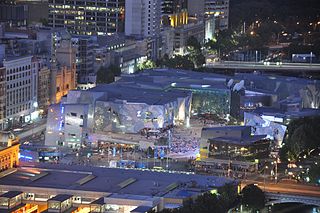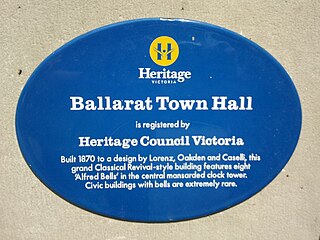
Federation Square is a venue for arts, culture and public events on the edge of the Melbourne central business district. It covers an area of 3.2 ha at the intersection of Flinders and Swanston Streets built above busy railway lines and across the road from Flinders Street station. It incorporates major cultural institutions such as the Ian Potter Centre, Australian Centre for the Moving Image (ACMI) and the Koorie Heritage Trust as well as cafes and bars in a series of buildings centred around a large paved square, and a glass walled atrium.

Parliament House is the meeting place of the Parliament of Victoria, one of the eight parliaments of the Australian states and territories.
Geoffrey Norman Blainey, is an Australian historian, academic, best selling author and commentator.

Spring Street is a major street in the Melbourne central business district, Australia. It runs roughly north-south and is the easternmost street in the original 1837 Hoddle Grid.

The Old Treasury Building on Spring Street in Melbourne was built in 1858-62 in the grand Renaissance Revival style. It was designed to accommodate the Treasury Department, various government officials' offices including the Governor In Council, and basement vaults intended to house gold from the Victorian gold rush. It now houses a range of functions, including a museum of Melbourne history, known as Old Treasury Building Museum.

Architecture of Australia has generally been consistent with architectural trends in the wider Western world, with some special adaptations to compensate for distinctive Australian climatic and cultural factors. Indigenous Australians produced a wide range of structures and places prior to colonisation. Contemporary Indigenous practitioners are active in a broad range of built environment fields. During Australia's early Western history, it was a collection of British colonies in which architectural styles were strongly influenced by British designs. However, the unique climate of Australia necessitated adaptations, and 20th-century trends reflected the increasing influence of American urban designs and a diversification of the cultural tastes and requirements of an increasingly multicultural Australian society.

Heritage Victoria is a branch of the Victorian Department of Transport and Planning. It is the regulator responsible for administering the Heritage Act 2017. The Heritage Act provides for the protection and conservation of the cultural heritage of Victoria and establishes the Victorian Heritage Register and Heritage Inventory. The Register is a list of places and objects which are of significance to the State of Victoria. The Inventory is a list of known historical archaeological sites. Both statutory lists can be searched via the Victorian Heritage Database.
Philip J. Goad is an Australian academic, currently serving as Professor of Architecture in the Faculty of Architecture, Building and Planning at the University of Melbourne. He is also a former President of the Victorian Chapter of the Royal Australian Institute of Architects. Phillip became Chair of the Heritage Council of Victoria in July 2021.

Melbourne is the capital and most populous city of the Australian state of Victoria, and the second-most populous city in Australia, after Sydney. Its name generally refers to a 9,993 km2 (3,858 sq mi) metropolitan area also known as Greater Melbourne, comprising an urban agglomeration of 31 local municipalities, although the name is also used specifically for the local municipality of City of Melbourne based around its central business area. The metropolis occupies much of the northern and eastern coastlines of Port Phillip Bay and spreads into the Mornington Peninsula, part of West Gippsland, as well as the hinterlands towards the Yarra Valley, the Dandenong Ranges, and the Macedon Ranges. As of 2023, the population of the metropolitan area was 5.2 million ; inhabitants are referred to as "Melburnians".
Edward Giles Stone was an Australian engineer prominent in many innovative, often daringly spectacular, aspects of early reinforced concrete constructions in Australia. He was also involved in cement manufacture. He was briefly a pioneer in prefab housing but that industry was destined to use timber, not concrete plates.
Robert John Adams is an Australian architect and urban designer based in Melbourne. He worked at the City of Melbourne, Australia for 40 years, 24 of those as Director of City Design and Projects. He won multiple awards as the leader of the revitalisation of the Melbourne central business district and surrounds, helping to create a vibrant city streetscape with innovative design features.
Timothy Andrew Murray is an Australian archaeologist. He joined the Archaeology department of La Trobe University in 1986 as a lecturer. On the retirement of the foundation Chair Professor Jim Allen, Murray was appointed to the Chair of Archaeology in 1995. He has also taught at the University of New South Wales, the University of Sydney, Cambridge University, the University of Leiden, the Université de Paris I (Panthéon-Sorbonne), the Ecole des hautes etudes en sciences sociales (Paris) and the Institute of Archaeology, University College London. He was elected a Fellow of the Society of Antiquaries of London in 2003 and Fellow of the Australian Academy of the Humanities in the same year.
The Council for the Historic Environment was a non government body established in 1977 in Victoria, Australia, to investigate, record and advice on heritage and building conservation. It was formed by a group of heritage professionals. academics and government bureaucrats. this was perhaps the first such group in Australia, which aimed to codify and raise the standard of professional practice amongst archaeologists, architects, engineers, historians, planners, etc.
David Beauchamp is a New Zealand born, Australian civil engineer who has contributed extensively to engineering heritage and research.

The APA Building was a skyscraper in Melbourne, Victoria, Australia; at 12 storeys and 53m to the tip of its corner spire, it became the Australia's tallest commercial building at the time of its completion in mid 1890 exceeding the previous height record set by of the Federal Coffee Palace. It was later reputed (erroneously) to have been the world's tallest at the time.
Robert Joseph Haddon (1866–1929) was an England-born architect who practised in Victoria in the 1900s-1910s. He was a major figure in the profession in Victoria, championing the Arts and Crafts in his writing and teaching. He designed some of the most original buildings of the period, featuring restraint, balanced asymmetry and Art Nouveau details.
Harriet Edquist is an Australian historian and curator, and Professor Emerita in the School of Architecture and Urban Design at RMIT University in Melbourne. Born and educated in Melbourne, she has published widely on and created numerous exhibitions in the field of Australian architecture, art and design history. She has also contributed to the production of Australian design knowledge as the founding editor of the RMIT Design Archives Journal and is a member of the Design Research Institute at RMIT University.

The South Lawn car park is a parking garage at the University of Melbourne constructed in 1971–72 using an innovative reinforced concrete shells with parabolic profiles supported on short columns structural system designed by Jan van der Molen, an engineer. The car park was added to the Victorian Heritage Register on 6 April 1994.
Oakden, Addison and Kemp was an Australian architectural firm in Melbourne, Victoria. While it was short lived, existing from only 1887 to 1892, they designed a number of outstanding projects, and all three members designed many more notable projects in earlier and later partnerships.
The National Trust of Australia (Victoria) is a community-based, non-government organisation committed to promoting and conserving Australia's indigenous, natural and historic heritage places of cultural significance in Victoria. It was founded in 1956.








